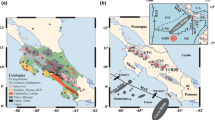Abstract
Our understanding of the tectonic framework for the formation of Tibet and the collision of India with Eurasia1 depends on our knowledge of the regional structure of the crust and upper mantle. Such basic information can be derived from seismic studies, but lateral inhomogeneities cause problems with interpretation of external observations, owing to the lack of stations inside a hardly accessible landmass. In 1982, as part of the French–Chinese cooperation programme, a network of long-period seismic stations was installed for the first time in southern Tibet itself with the object of obtaining local pure-path seismic data. Previously (with the exception of ref. 2) pure-path Tibet dispersion curves were extracted from mixed-path observations3–9, which required assumptions about neighbouring regions and focal mechanisms. In this study, local Rayleigh phase-velocity dispersions from the network were inverted to yield S-wave velocity models. As the period range of the data extends beyond 120 s, the information so obtained constrains deep-seated structures down to 200 km. The crust is shown to be very thick (65–70 km), in accordance with previous estimates2–9, and is divided into an upper part with a velocity of 3.2 km s−1 and a lower part with a steep velocity gradient. The underlying mantle has a high velocity lid (Vs = 4.7 km s−1), beneath which the structure resembles that of western Europe, with a relatively weak velocity minimum (compared with active tectonic regions) of 4.36 km s−1 at a depth of 150 km.
Similar content being viewed by others
References
Molnar, P. & Tapponnier, P. J. geophys. Res. 85, 5361–5375 (1978).
Romanowicz, B. J. geophys. Res. 87, 6865–6883 (1982).
Patton, H. Rev. Geophys. Space Phys. 18, 605–625 (1980).
Gupta, H. K. & Narain, H. Bull. seismol. Soc. Am. 57, 235–248 (1967).
Chun, K. Y. & Yoshii, T. Bull. seismol. Soc. Am. 67, 737–750 (1977).
Tung, J. P. & Teng, L. EOS 55, 359 (1974).
Chen, W. P. & Molnar, P. J. J. geophys. Res. 86, 5937–5961 (1981).
Yao, Zh. X. et al. Acta geophys. sin. 24, 287–295 (1981).
Pines, I., Teng, T., Rosenthal, R. & Alexander, S. J. geophys. Res. 85, 3829–3844 (1980).
Fels, J. F. Notice technique de l' lnstitut de Physique du Globe (Paris, 1977).
Souriau, A. thesis, Univ. Pierre et Marie Curie (1978).
Knopoff, L. et al. Bull. seismol. Soc. Am. 56, 1009–1044 (1966).
Tapponnier, P. et al. in Collision Tectonics (eds Ries, A. & Coward, M. ) (Geological Society of London, 1984).
Barazangi, M. & Ni, J. Proc. Int. Un. Geodesy. Geophys. General Assembly (Hamburg), 49 (1984).
Cara, M., Nercessian, A. & Nolet, G. Geophys. J. R. astr. Soc. 61, 459–478 (1980).
Tarantola, A. & Valette, B. Rev. Geophys. Space Phys. 20, 219–232 (1982).
Hirn, A. et al. Nature 307, 23–25 (1984).
Hirn, A. et al. Nature 307, 25–27 (1984).
Ni, J. & Barazangi, M. Geophys. J. R. astr. Soc. 72, 665–689 (1983).
Knopoff, L. Geophys. J. R. astr. Soc. 74, 55–81 (1983).
Feng, Ch. & Teng, T. L. J. geophys. Res. 88, 2261–2272 (1983).
Gilbert, S. & Dziewonski, A. M. Phil. Trans. R. Soc. 278, 187–269 (1975).
Author information
Authors and Affiliations
Rights and permissions
About this article
Cite this article
Jobert, N., Journet, B., Jobert, G. et al. Deep structure of southern Tibet inferred from the dispersion of Rayleigh waves through a long-period seismic network. Nature 313, 386–388 (1985). https://doi.org/10.1038/313386a0
Received:
Accepted:
Issue Date:
DOI: https://doi.org/10.1038/313386a0
- Springer Nature Limited
This article is cited by
-
Uncertainties in Prediction of Near-Fault Long-Period Ground Motion: An Application to the 1970 Tonghai Earthquake (Ms 7.8)
Pure and Applied Geophysics (2022)
-
Shear-wave velocity structure of the crust and uppermost mantle in the Shanxi rift zone
Earthquake Science (2015)
-
Love and Rayleigh Wave Tomography of the Qinghai-Tibet Plateau and Surrounding Areas
Pure and Applied Geophysics (2010)
-
Travel time tomography inversion and the deep structure of the southern Tibet
Acta Seismologica Sinica (1996)
-
Three-dimensional seismic velocity structure of the Tibetan Plateau and its eastern neighboring areas with implications to the model of collision between continents
Acta Seismologica Sinica (1993)





